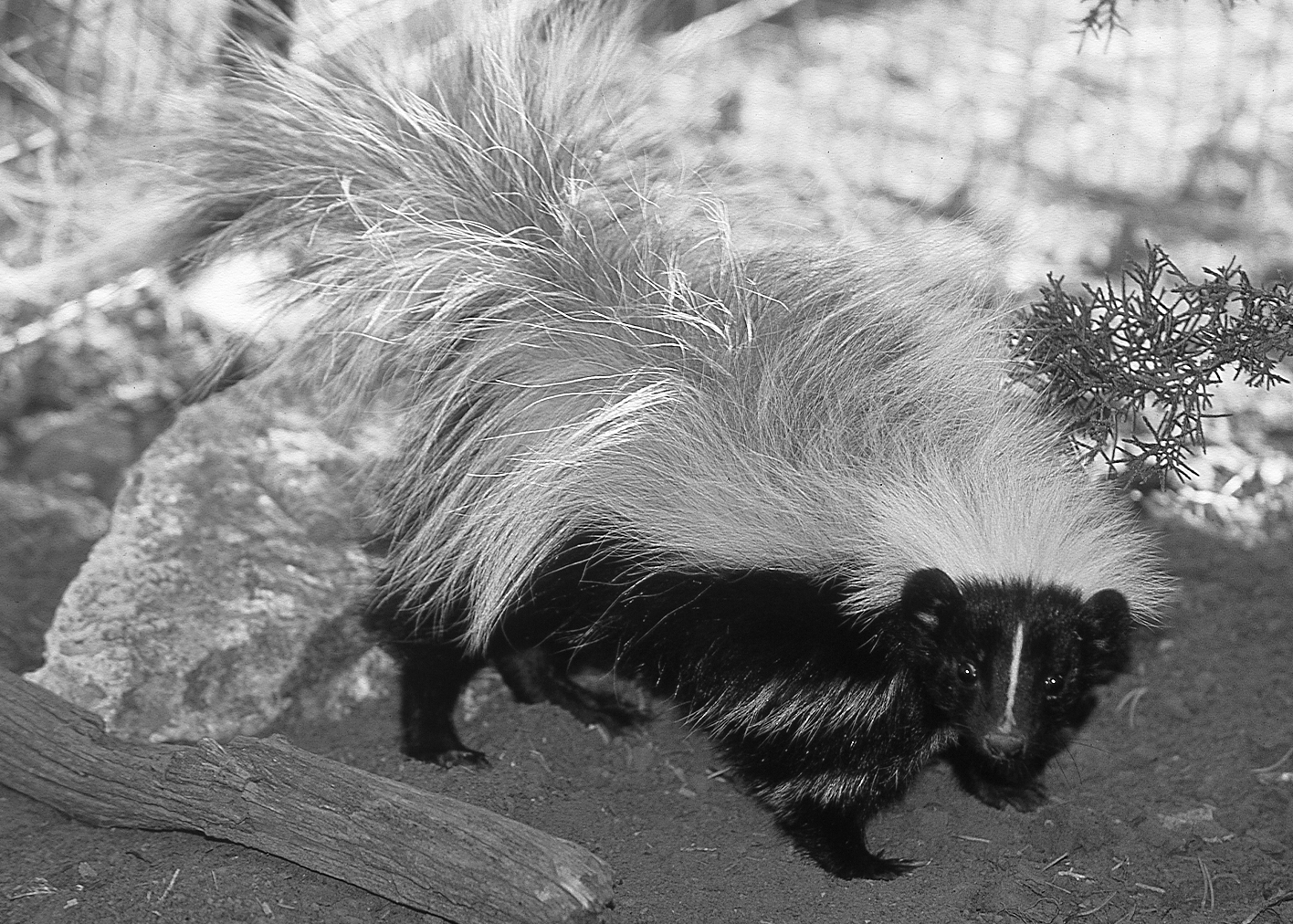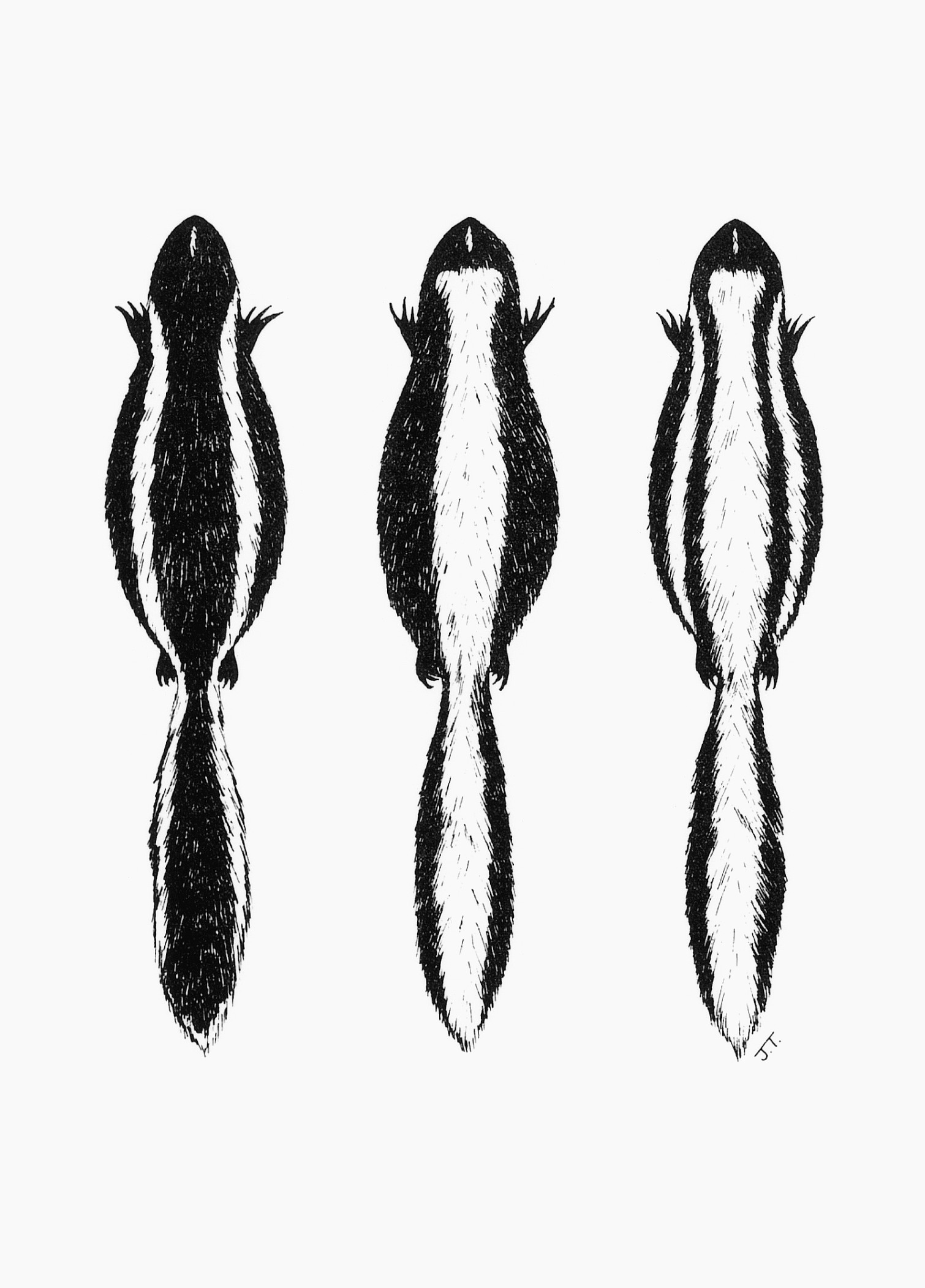HOODED SKUNK
Mephitis macroura Lichtenstein 1832
Order Carnivora : Family Mephitidae
DESCRIPTION. Superficially similar to the striped skunk, Mephitis mephitis, but differs in having longer, softer fur and a distinct ruff of longer hair on the upper neck. Three color patterns: a white-backed phase with upperparts chiefly white, frequently with two narrow, short white stripes on each side behind shoulder, and underparts black or mottled with white; a black-backed phase with upperparts black, except for two narrow lateral white stripes, and underside of tail frequently white (occasionally tail wholly black, but bases of hairs always white); and a combination phase that is intermediate between the white-backed and black-backed forms (see figure below). In the white-backed phase, a broad white band begins between the eyes and covers most of the back and upper surface of the tail; the white stripe never bifurcates as in the striped skunk. Differs from the hog-nosed skunk in much finer fur, small snout, smaller size, and much longer tail. Dental formula: I 3/3, C 1/1, Pm 3/3, M 1/2 × 2 = 34. External measurements of an adult male: total length, 700 mm; tail, 377 mm; hind foot, 69 mm; of adult female, 650-370-60 mm. Weight of males, 800–900 g; of females, 400–700 g.


DISTRIBUTION. Primarily a Mexican species. Occurs in Texas in the central Trans-Pecos region. Recorded definitely only from Brewster, Jeff Davis, Pecos, Presidio, Reeves, and Ward counties.

SUBSPECIES. Mephitis m. milleri.
HABITS. These slender, white-sided skunks occur along stream courses where they prefer rocky ledges or tangles of streamside vegetation for safety. Occasionally they resort to burrows in the banks of washes. One captured in Brewster County was trapped in a heavy stand of willows along the sandy banks of Tornillo Creek. It had been feeding in that vicinity in company with hog-nosed skunks.
Little is known of the natural history of hooded skunks. Males and females are in breeding condition from the middle of February to the last of March. Two litters, each consisting of three individuals, have been recorded. Hooded skunks are primarily insectivorous, although they also eat some vertebrates (shrews and rodents) as well as plant materials (prickly pear fruit).
POPULATION STATUS. Rare. The hooded skunk was not documented in Texas by Vernon Bailey in 1905 when he published the first account of mammals in the state. The first Texas specimens were reported from Fort Stockton, Pecos County, in 1925 and from near Mt. Livermore, Jeff Davis County, in 1940. A few other records have been reported since, but this is the rarest skunk in western Texas, with the last specimen having been collected in 1999. Robert Patton, who was the first PhD student of DJS at Texas A&M University, conducted an ecological study of skunks near Balmorhea, Jeff Davis County, and he reported sighting a few hooded skunks in the vicinity of Balmorhea Lake Dam in the early 1970s. Other naturalists have returned to this site since and have not recorded any hooded skunks, and some mammalogists believe the species could be extinct in Texas.
CONSERVATION STATUS. The IUCN lists the hooded skunk's status as least concern and increasing in numbers, although this does not seem to be true in Texas. It is not listed by TPWD and USFWS. The reason for the decline is unclear, but this is a species that should be carefully monitored in the future and probably warrants some type of protection status now.
From The Mammals of Texas, Seventh Edition by David J. Schmidly and Robert D. Bradley, copyright © 1994, 2004, 2016. Courtesy of the University of Texas Press.
Natural Science Research Laboratory
-
Address
Museum of Texas Tech University, 3301 4th street, Lubbock, TX 79409 -
Phone
806.742.2486 -
Email
nsrl.museum@ttu.edu

